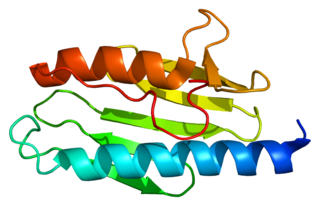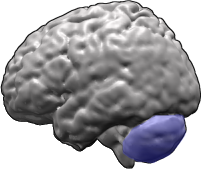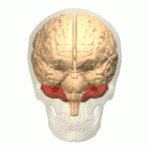Management
This section is empty.You can help by adding to it.(March 2018) |
| Scanning speech | |
|---|---|
| Other names | Explosive speech |
| Specialty | Neurology |
Scanning speech is a type of ataxic dysarthria in which spoken words are broken up into separate syllables, often separated by a noticeable pause, and spoken with varying force. [1] The sentence "Walking is good exercise", for example, might be pronounced as "Walk (pause) ing is good ex (pause) er (pause) cise". Additionally, stress may be placed on unusual syllables.
The name is derived from literary scansion, because the speech pattern separates the syllables in a phrase much like scanning a poem counts the syllables in a line of poetry. [2]
There is no universal agreement about the exact definition of this term. [2] Some sources require only a noticeable pause between syllables, while others require other speech abnormalities, such as the unusual stress pattern on syllables. Some sources consider it a common, but not necessary, feature of ataxic dysarthria; others consider it exactly synonymous with ataxic dysarthria. [2]
Scanning speech, like other ataxic dysarthrias, is a symptom of lesions in the cerebellum. [1] It is a typical symptom of multiple sclerosis, [3] and it constitutes one of the three symptoms of Charcot's neurologic triad. [4]
Scanning speech may be accompanied by other symptoms of cerebellar damage, such as gait, truncal and limb ataxia, intention tremor, inaccuracies in rapidly repeated movements and sudden, abrupt nausea and vomiting. The handwriting of such patients may also be abnormally large. [5]
This section is empty.You can help by adding to it.(March 2018) |
Ataxia is a neurological sign consisting of lack of voluntary coordination of muscle movements that can include gait abnormality, speech changes, and abnormalities in eye movements. Ataxia is a clinical manifestation indicating dysfunction of the parts of the nervous system that coordinate movement, such as the cerebellum. Ataxia can be limited to one side of the body, which is referred to as hemiataxia. Several possible causes exist for these patterns of neurological dysfunction. Dystaxia is a mild degree of ataxia. Friedreich's ataxia has gait abnormality as the most commonly presented symptom. The word is from Greek α- [a negative prefix] + -τάξις [order] = "lack of order".

A tremor is an involuntary, somewhat rhythmic, muscle contraction and relaxation involving oscillations or twitching movements of one or more body parts. It is the most common of all involuntary movements and can affect the hands, arms, eyes, face, head, vocal folds, trunk, and legs. Most tremors occur in the hands. In some people, a tremor is a symptom of another neurological disorder. A very common tremor is the teeth chattering, usually induced by cold temperatures or by fear.

Cerebellar hypoplasia is characterized by reduced cerebellar volume, even though cerebellar shape is (near) normal. It consists of a heterogeneous group of disorders of cerebellar maldevelopment presenting as early-onset non progressive ataxia, hypotonia and motor learning disability.
Dysarthria is a motor speech disorder resulting from neurological injury of the motor component of the motor–speech system and is characterized by poor articulation of phonemes. In other words, it is a condition in which problems effectively occur with the muscles that help produce speech, often making it very difficult to pronounce words. It is unrelated to problems with understanding language, although a person can have both. Any of the speech subsystems can be affected, leading to impairments in intelligibility, audibility, naturalness, and efficiency of vocal communication. Dysarthria that has progressed to a total loss of speech is referred to as anarthria. The term dysarthria is from New Latin, dys- "dysfunctional, impaired" and arthr- "joint, vocal articulation").
Ataxia–telangiectasia, also referred to as ataxia–telangiectasia syndrome or Louis–Bar syndrome, is a rare, neurodegenerative, autosomal recessive disease causing severe disability. Ataxia refers to poor coordination and telangiectasia to small dilated blood vessels, both of which are hallmarks of the disease.
Progressive supranuclear palsy (PSP) is a degenerative disease involving the gradual deterioration and death of specific volumes of the brain. The condition leads to symptoms including loss of balance, slowing of movement, difficulty moving the eyes, and dementia. PSP may be mistaken for other neurodegenerative diseases such as Parkinson's and Alzheimer's. The cause of the condition is uncertain, but involves accumulation of tau protein within the brain. Medications such as levodopa and amantadine may be useful in some cases.

Friedreich's ataxia is an autosomal recessive genetic disease that causes difficulty walking, a loss of sensation in the arms and legs and impaired speech that worsens over time. Symptoms can start between 5 and 15 years of age. Many develop hypertrophic cardiomyopathy and will require a mobility aid such as a cane, walker or wheelchair in their teens. As the disease progresses, people lose their sight and hearing. Other complications include scoliosis and diabetes mellitus.

Spinocerebellar ataxia (SCA) is a progressive, degenerative, genetic disease with multiple types, each of which could be considered a neurological condition in its own right. An estimated 150,000 people in the United States have a diagnosis of spinocerebellar ataxia at any given time. SCA is hereditary, progressive, degenerative, and often fatal. There is no known effective treatment or cure. SCA can affect anyone of any age. The disease is caused by either a recessive or dominant gene. In many cases people are not aware that they carry a relevant gene until they have children who begin to show signs of having the disorder.
Dysdiadochokinesia (DDK) is the medical term for an impaired ability to perform rapid, alternating movements. Complete inability is called adiadochokinesia. The term is from Greek δυςdys "bad", διάδοχοςdiadochos "succeeding", κίνησιςkinesis "movement".
Cerebellar ataxia is a form of ataxia originating in the cerebellum. Non-progressive congenital ataxia (NPCA) is a classical presentation of cerebral ataxias.
Intention tremor is a dyskinetic disorder characterized by a broad, coarse, and low frequency tremor. The amplitude of an intention tremor increases as an extremity approaches the endpoint of deliberate and visually guided movement. An intention tremor is usually perpendicular to the direction of movement. When experiencing an intention tremor, one often overshoots or undershoots one's target, a condition known as dysmetria. Intention tremor is the result of dysfunction of the cerebellum, particularly on the same side as the tremor in the lateral zone, which controls visually guided movements. Depending on the location of cerebellar damage, these tremors can be either unilateral or bilateral.

Dyschronometria is a condition of cerebellar dysfunction in which an individual cannot accurately estimate the amount of time that has passed. It is associated with cerebellar ataxia, when the cerebellum has been damaged and does not function to its fullest ability. Lesions to the cerebellum can cause dyssynergia, dysmetria, dysdiadochokinesia, dysarthria, and ataxia of stance and gait. Dyschronometria can result from autosomal dominant cerebellar ataxia (ADCA).
Bruns apraxia, or frontal ataxia is a gait apraxia found in patients with bilateral frontal lobe disorders. It is characterised by an inability to initiate the process of walking, despite the power and coordination of the legs being normal when tested in the seated or lying position. The gait is broad-based with short steps with a tendency to fall backwards. It was originally described in patients with frontal lobe tumours, but is now more commonly seen in patients with cerebrovascular disease.

Vestibulocerebellar syndrome, also known as vestibulocerebellar ataxia, is a progressive neurological disorder that causes a variety of medical problems. Initially symptoms present as periodic attacks of abnormal eye movements but may intensify to longer-lasting motor incapacity. The disorder has been localized to the vestibulocerebellum, specifically the flocculonodular lobe. Symptoms of vestibulocerebellar syndrome may appear in early childhood but the full onset of neurological symptoms including nystagmus, ataxia, and tinnitus does not occur until early adulthood. To date, vestibulocerebellar syndrome has only been identified in three families but has affected multiple generations within them. Based on the familial pedigrees it has been characterized as an autosomal dominant disorder, although the exact genetic locus has not been identified. It has been found to be genetically distinct from other seemingly similar forms of neurological syndromes such as episodic ataxia types 1 and 2. Due to its rarity, however, little is known about specific details of the pathology or long-term treatment options. There is currently no cure for vestibulocerebellar syndrome, although some drug therapies have been effective in alleviating particular symptoms of the disorder.

Ataxic cerebral palsy is clinically observed in approximately 5-10% of all cases of cerebral palsy, making it the least frequent form of cerebral palsy diagnosed. Ataxic cerebral palsy is caused by damage to cerebellar structures, differentiating it from the other two forms of cerebral palsy, which are spastic cerebral palsy and athetoid cerebral palsy.

Autosomal recessive cerebellar ataxia type 1 (ARCA1) is a condition characterized by progressive problems with movement. Signs and symptoms of the disorder first appear in early to mid-adulthood. People with this condition initially experience impaired speech (dysarthria), problems with coordination and balance (ataxia), or both. They may also have difficulty with movements that involve judging distance or scale (dysmetria). Other features of ARCA1 include abnormal eye movements (nystagmus) and problems following the movements of objects with their eyes. The movement problems are slowly progressive, often resulting in the need for a cane, walker, or wheelchair.

Autosomal dominant cerebellar ataxia (ADCA) is a form of spinocerebellar ataxia inherited in an autosomal dominant manner. ADCA is a genetically inherited condition that causes deterioration of the nervous system leading to disorder and a decrease or loss of function to regions of the body.

Spinocerebellar ataxia type 1 (SCA1) is a rare autosomal dominant disorder, which, like other spinocerebellar ataxias, is characterized by neurological symptoms including dysarthria, hypermetric saccades, and ataxia of gait and stance. This cerebellar dysfunction is progressive and permanent. First onset of symptoms is normally between 30 and 40 years of age, though juvenile onset can occur. Death typically occurs within 10 to 30 years from onset.
COACH syndrome, also known as Joubert syndrome with hepatic defect, is a rare autosomal recessive genetic disease. The name is an acronym of the defining signs: cerebellar vermis aplasia, oligophrenia, congenital ataxia, coloboma and hepatic fibrosis. The condition is associated with moderate intellectual disability. It falls under the category of a Joubart Syndrome-related disorder (JSRD).

Cerebellar degeneration is a condition in which cerebellar cells, otherwise known as neurons, become damaged and progressively weaken in the cerebellum. There are two types of cerebellar degeneration; paraneoplastic cerebellar degeneration, and alcoholic or nutritional cerebellar degeneration. As the cerebellum contributes to the coordination and regulation of motor activities, as well as controlling equilibrium of the human body, any degeneration to this part of the organ can be life-threatening. Cerebellar degeneration can result in disorders in fine movement, posture, and motor learning in humans, due to a disturbance of the vestibular system. This condition may not only cause cerebellar damage on a temporary or permanent basis, but can also affect other tissues of the central nervous system, those including the cerebral cortex, spinal cord and the brainstem.
| Classification |
|---|